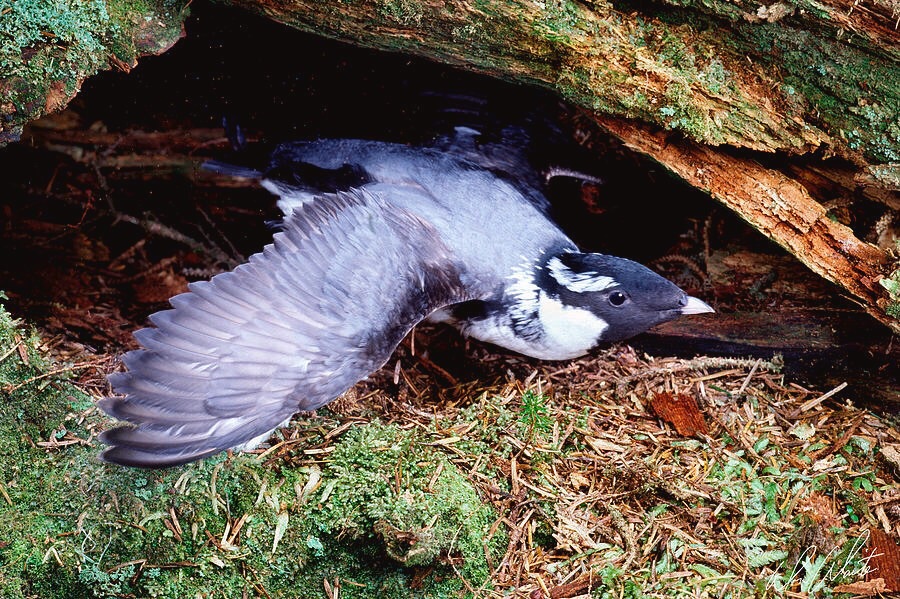I’m quite sure that this is going to be a controversial topic; especially because my associates and I often use high-speed strobes to photograph the smaller birds such as kinglets, bushtits, creepers and the smaller wrens. Our reasoning is quite simple, these tiny birds move so quickly that they can literally fly 3-4 feet before one has time to hit the firing button on the remote. Occasionally my young grandchildren accompany out into the bush to photograph one of these tiny birds coming and going from its nest. It’s amazing that their reflexes are so much faster than mine. I’ll have my camera and strobes set to fire at 3-frames per second. The strobes, set at a reasonable distance from the nest and at 1/8 or 1/16 power, are usually able to stop these birds in flight. Many novice photographers probably don’t know it but light from strobes diminish as the square of the distance. For example, strobes set at 4 feet from a subject are 4 times more powerful than the same power of strobes set at 16 feet.
I tell my grandkids to hit the button as soon as the bird takes flight from any branch that’s less than 5-feet away from the nest. If they are lucky, the middle or last frame captures the bird. As often as not, they capture nothing at all and birds such as the Black-capped Chickadees, Pacific Wrens, and Brown Creepers disappear into their nest cavity without being photographed.
I am certainly not an optamologist and I don’t pretend to know much about a bird’s retina. As a layman – and a kid going to matinee movies – I recall exiting the dark theatre and going into bright sunlight. The retinas of my eyes closed down to pinpoints just like the iris of a lens closes down to f-16, f-22, or even smaller. It makes sense to me that photographing birds in bright sunlight with strobes powered down to a short flash duration would not harm the subjects. Their irises would be so pinpointed that the flash duration of the powered down strobes (as short as 1/10,000 second) would have nil effect.
I began my bird photography in the mid-1970s at a time when it was quite acceptable to photograph nocturnal birds bringing food into their babies in pitch darkness. An older associate – who was separated from me by 3,000 miles – photographed owls 25+ feet up in a tree. He and his partner used scaffolding to reach the same height as the nest. At twilight the two photographers set their high-powered strobes and prefocused the camera in readiness for nightfall. Concealed in a large blind, they illuminated the nest with a low-voltage flashlight to watch as the parents came in with food, most often a dead rat but on occasion a dead songbird. The bright flash of their strobes in the pitch darkness had to have blinded all the birds at the nest. The irises of these birds would have been wide open on account of the darkness.
I was not immune to this type of photography and in 1985 accompanied government employees to a seabird reserve to photograph murrelets and auklets. I used a very elaborate triggering device (for the time anyway) which caused the adult bird to take its own portrait upon exiting the burrow by stepping on the triggering platform. Totally blinded, the birds often flew full tilt into trees.

An Ancient Murrelet captures its own portrait by stepping on a photo-electric triggering device coupled to the Kenneth A. Olson’s 4-unit strobes that were in turn connected to a Hasselblad Electronic body with a telephoto lens. The strobes were as big as dinner plates and kicked out far more light than any of the commercial units now on the market. This capture was taken at 1/500 second at f-22 on the camera with the flash units, set 4-feet away from the nest firing at an incredible 1/20,000 second. The image was taken on Kodak Ektachrome 64 film. Taken on Reef Island, Haida Gwaii (Queen Charlotte Islands), 1985.
As of late, I’ve spent a great deal of time perusing other professional wildlife photographers websites and finding images of owls with black backgrounds. To me, it’s pretty obvious that these captures took place at night and in the dark. This type of photography is totally unacceptable today and is definitely harassing the owl – and as such is subject to charges under Canada’s Migratory Birds Conventions Act.
An associate and I were charged under the Migragtory Birds Conventions Act and the Species at Risk Act in 2007. There were 18 indictable (criminal) charges in total and the maximum fines were a staggering $4,500,000. These fines are much higher today.

Leave A Comment